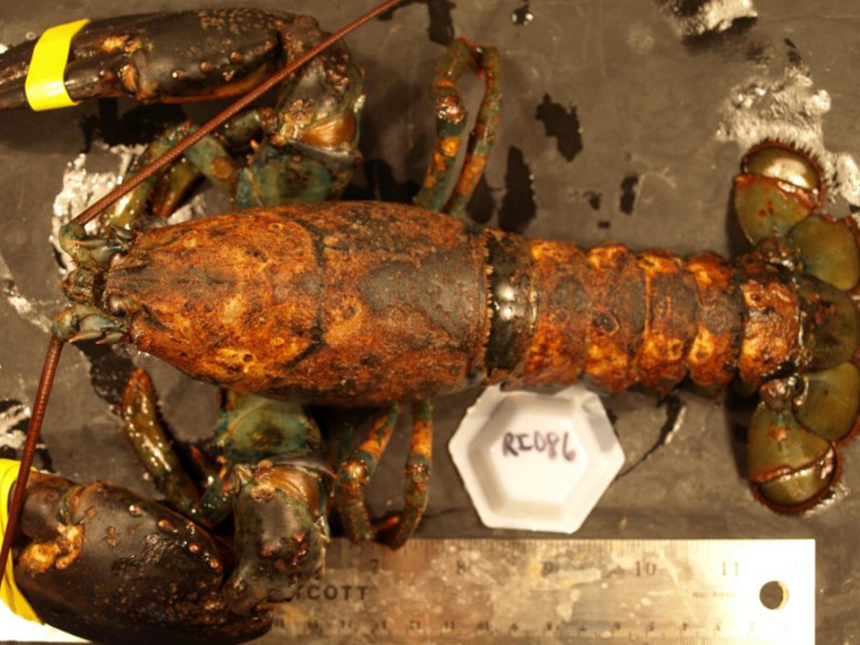Solution to Lobster Shell Disease Remains Elusive: Blindness is also a growing concern
By TODD McLEISH/ecoRI
News contributor

Epizootic shell disease can lead to pitting, erosion, and the darkening of a lobster’s carapace. Survival of moderately and severely diseased lobsters, those with disease on more than 10 percent of their cuticle, is only 30 percent that of healthy animals. (Jeff Shields/VIMS)
Despite more than 20 years of declining lobster populations in southern New England and extensive studies of the shell disease that is a major factor in their decline, scientists are still struggling to provide definitive answers to help restore hope to those working in the local lobster fishery.
A new study of lobsters
along the eastern Connecticut coast has found that the disease is linked to
warming water temperatures, while progress is slow in efforts to identify
probiotics to counteract the disease and to better understand why so many
lobsters are blind.
“Epizootic shell disease first appeared around 1996 and became quite prevalent around 1999, and it continues to be prevalent,” said Maya Groner, who conducted the Connecticut study as a post-doctoral researcher at the Virginia Institute of Marine Science.
“It’s been a challenge to figure out what the pathogen associated with the disease is. The best evidence suggests it may be a suite of bacteria that chews away at the carapace, but that suite of bacteria changes over the course of the disease.”
Her study found that the
increased prevalence of the disease stems from warmer water temperatures that
induce the lobsters to molt their shells earlier than usual.
Using data on 200,000
lobsters collected over 37 years in Waterford, Conn., as part of biological
monitoring near the Millstone Nuclear Power Station, Groner found that about 80
percent of male lobsters have the disease during warm years, with females
contracting the disease at a slightly lower rate.
“Molting their shell
resets their health,” she said. “If they don’t molt, there’s no way they can
recover. But now that they’re molting earlier in the spring, the molt happens
before they’re even challenged with the disease.”
The earlier molt allows
the disease to progress longer than if the lobsters molted in summer, as they
typically do.
Groner found that for
every 1.8-degree increase in the average temperature of the bottom water in
May, lobsters molted about six days earlier. In early-molting years, disease
prevalence doubled by September.
“It’s very consistent
with trends we’ve seen with other marine diseases,” Groner said. “Organisms at
the southern part of their range — like lobsters in Long Island Sound — are
limited by temperature. They’re at their thermal tolerance limit. So as
temperatures increase, they’re becoming stressed and less able to cope with
diseases.”
University of Rhode
Island fisheries researcher Kathy Castro has been studying lobsters for more
than two decades, and she decided to look for a solution to help lobsters
recover from the disease even though the precise cause of the disease is still
uncertain. She is collaborating with URI colleagues who are studying probiotics
on oysters.
“Why can’t we identify
good bacteria that normally occur on lobsters, take the bad bacteria off, and
repopulate their shells with good bacteria?” she wondered. “In essence, the
idea works, but we don’t know what’s the right bacteria, how do we treat the
lobsters, how often, and how to do it in a reasonable time frame.”
In a laboratory setting,
Castro’s URI colleagues David Nelson and David Rowley isolated probiotics from
healthy lobsters and tested them against what they believe may be the “bad
bacteria.” The strategy looked promising. Initial trials on adult lobsters were
positive as well. But it may not be practical.
“Our initial idea was
that lobstermen could treat the lobsters on their boat,” Castro said. “But it’s
hard to do; you have to do it in a lab. Maybe we still haven’t identified the
right probiotic. And are we even working with the right pathogens?”
While that work is
continuing, Castro is investigating why about half of the lobsters she has
tested are functionally blind.
“That’s a more
concerning issue to me than shell disease,” she said. “My question is, is it
related to shell disease. The lobster’s endocrine control system is located in
their eye stalk, so if a lobster is blind, is it molting incorrectly, and is
that contributing to the disease.”
Castro said a colleague
in Virginia thinks the cause of the blindness may be manganese, a neurotoxin
that harms optic nerves and is released from sediments under low-oxygen
conditions. But studies are just now under way.
“In my mind, it has to
be related to shell disease. That’s my gut feeling,” Castro said.
One of the challenges to
finding the answers has been inadequate research funding, Castro said, so much
of the research is being done piecemeal.
“I really wish there was
something fundamentally easy that we could do to solve all these problems,” she
said. “That would be my greatest dream. But I know it takes time. And as much
as we know about lobsters, there’s a lot more we don’t know.”
Rhode Island resident
and author Todd McLeish runs a wildlife blog.